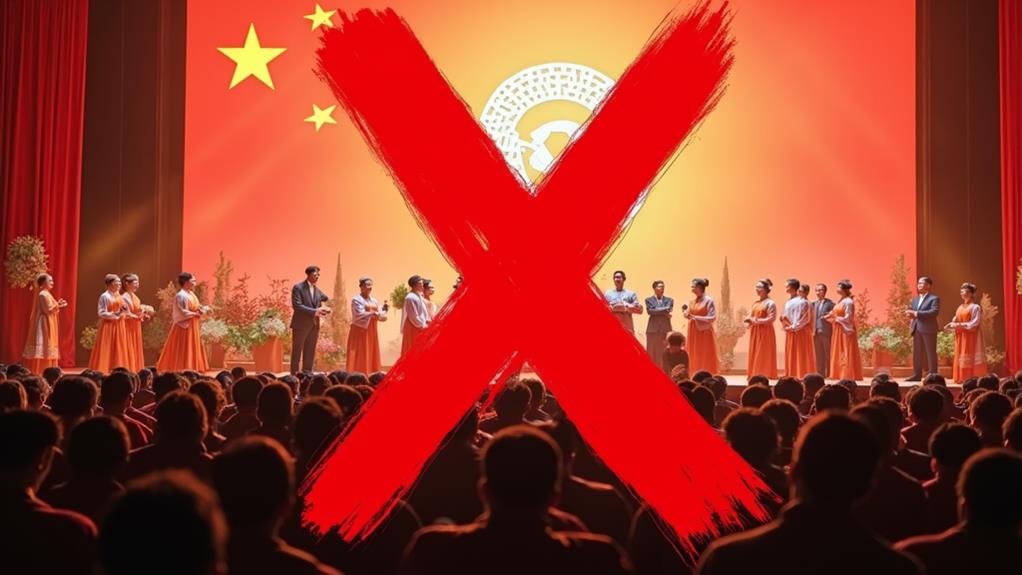When a popular cultural phenomenon raises more than a few eyebrows, it’s worth exploring the underlying issues. In the case of Shen Yun, the world-renowned performing arts company, its mesmerizing dance routines and stunning costumes have been overshadowed by a multitude of concerns. You may have heard whispers about the company’s ties to a certain spiritual practice, allegations of propaganda, or claims of human rights abuses. But what’s really behind the controversy surrounding Shen Yun? As you look closer, you’ll find a complex web of issues that challenge the very fabric of this seemingly innocent dance troupe. Now let explore reasons behind Shen Yun Controversy.
Contents
- 1 Key Takeaways
- 2 Ties to Falun Gong Movement
- 3 Propaganda Allegations and Concerns
- 4 Human Rights Abuses Claims
- 5 Perceived Anti-CCP Agenda
- 6 Lack of Transparency Issues
- 7 Exaggerated Claims of Persecution
- 8 Controversial Portrayal of History
- 9 Frequently Asked Questions: Shen Yun Controversy
- 9.1 Is Shen Yun Available to Watch on Public Streaming Platforms?
- 9.2 Can Non-Practitioners Attend Shen Yun Performances?
- 9.3 Are Shen Yun Performers Required to Be Falun Gong Practitioners?
- 9.4 Does Shen Yun Offer Financial Aid to Low-Income Attendees?
- 9.5 Are Shen Yun World Tours Entirely Self-Funded?
- 10 Conclusion
Key Takeaways
- Shen Yun’s ties to Falun Gong raise concerns about its artistic integrity and potential for proselytizing through performances.
- Allegations of persecution of Falun Gong practitioners and human rights abuses in China surround Shen Yun.
- Government ties and propaganda allegations question Shen Yun’s use as a platform for Chinese soft power.
- Criticisms of Shen Yun’s historical accuracy and cultural insensitivity in its depiction of Chinese history and culture.
- Claims of promoting an anti-CCP agenda through performances and exaggerating persecution in China have been made against Shen Yun.
Ties to Falun Gong Movement
Shen Yun’s ties to the Falun Gong movement are frequently cited as a point of controversy surrounding the performing arts company.
As you explore the connection between Shen Yun and Falun Gong, you’ll find that the movement’s spiritual roots play a significant role. Falun Gong, also known as Falun Dafa, is a spiritual practice that combines meditation, qigong exercises, and moral teachings.
Shen Yun’s founders are practitioners of Falun Gong, and the company’s performances often incorporate elements of the practice.
Some critics have labeled Falun Gong a cult following, citing its hierarchical structure and emphasis on devotion to the movement’s founder, Li Hongzhi.
However, proponents argue that Falun Gong is a legitimate spiritual practice that promotes moral values and personal growth.
Shen Yun’s connection to Falun Gong has led to concerns about the company’s intentions and the potential for proselytizing through its performances.
While Shen Yun maintains that its mission is to promote traditional Chinese culture, the association with Falun Gong remains a contentious issue.
You’ll need to weigh these factors as you evaluate the controversy surrounding Shen Yun.
Propaganda Allegations and Concerns
As you examine the Shen Yun controversy, you’ll come across allegations that the performance is more than just a cultural show – it’s a vehicle for propaganda.
Critics argue that Shen Yun’s ties to the Chinese government, or rather the lack thereof, and its connections to Falun Gong have led to a hidden agenda being revealed.
You’ll need to ponder the evidence that government ties have been exposed and whether Shen Yun’s message is truly a reflection of Chinese culture or a manipulated narrative.
Government Ties Exposed
Government ties to Shen Yun have long been a topic of debate, with allegations emerging that the dance company serves as a propaganda tool for the Chinese government.
When you examine the company’s funding sources, you’ll find that Shen Yun has received government funding from the Chinese government in various forms. While this doesn’t necessarily prove a direct connection, it raises concerns about potential government influence over the company’s artistic content.
You may also notice that Shen Yun’s performances are often met with diplomatic pressure from the Chinese government. When Shen Yun tours internationally, Chinese diplomats and embassy officials frequently lobby host countries to cancel or restrict the performances.
This raises questions about the government’s motives and whether Shen Yun’s performances are being used as a tool for Chinese soft power. As you consider these factors, you’ll begin to understand why some people view Shen Yun as a propaganda tool for the Chinese government.
The situation becomes increasingly complex when you factor in the company’s own denials of government ties.
Hidden Agenda Revealed
Concerns about Shen Yun’s government ties and diplomatic pressure from the Chinese government raise questions about the true purpose of the dance company’s performances.
You might find yourself wondering if Shen Yun’s shows are more than just a display of traditional Chinese dance and music. Critics argue that the company uses its performances as a platform to spread propaganda and promote a specific ideology.
This has led to allegations of cultural appropriation, with some accusing Shen Yun of using Chinese culture to further its own agenda.
When you watch a Shen Yun performance, you might notice that the company takes artistic license with traditional Chinese stories and legends.
However, some argue that this license isn’t just artistic, but also ideological. Shen Yun’s portrayal of Chinese history and culture has been criticized for being overly simplistic and biased.
As you consider the controversy surrounding Shen Yun, it’s vital to think critically about the company’s intentions and the potential impact of its performances on audiences worldwide.
Human Rights Abuses Claims
As you examine the controversy surrounding Shen Yun, you’ll find that human rights abuses claims are a significant part of the debate.
You’ll discover allegations of persecution of Falun Gong practitioners, who are associated with Shen Yun, and reports of China’s labor camps, where many believe Falun Gong members have been detained.
You’ll also come across claims of organ harvesting, a practice allegedly linked to China’s treatment of Falun Gong detainees.
Persecution of Falun Gong
Millions of Falun Gong practitioners worldwide have been impacted by China’s severe crackdown on their spiritual movement.
You see this as a complex issue with moral ambiguity, as the Chinese government views Falun Gong as a threat to its authority.
China’s persecution of Falun Gong began in 1999, and since then, practitioners have reported widespread human rights abuses, including arbitrary arrests, detention, and torture.
As you look into this issue, you realize that Falun Gong practitioners are fighting for spiritual freedom, which is a fundamental human right.
This right is enshrined in international human rights law, including the Universal Declaration of Human Rights.
However, China’s actions against Falun Gong have been criticized by human rights organizations and governments worldwide.
You also find that the persecution of Falun Gong has led to a significant number of refugees and asylum seekers, seeking protection from persecution in other countries.
The international community continues to monitor this situation, calling on China to respect the rights of Falun Gong practitioners and to end its persecution of this spiritual movement.
China’s Labor Camps
China’s persecution of Falun Gong has led to widespread allegations of human rights abuses in its labor camps, also known as laogai.
If you’re familiar with the term, you might associate it with forced labor, but it’s more than that.
These camps are notorious for their harsh prison conditions, which have been well-documented by human rights organizations.
- Prisoners in labor camps are subjected to physical labor for up to 12 hours a day, often in poor conditions.
- They’re forced to work in hazardous environments, such as coal mines, without proper safety equipment.
- Prisoners are often malnourished and receive inadequate medical care, leading to widespread health problems.
- The use of torture and physical abuse is common in labor camps, with prisoners facing punishment for even minor infractions.
- Conditions in labor camps are often unsanitary, with prisoners forced to live in cramped and dirty quarters.
You should know that China’s labor camps have been shrouded in secrecy, making it difficult to verify the full extent of human rights abuses.
However, reports from former prisoners and human rights organizations paint a disturbing picture of life inside these camps.
Organ Harvesting Allegations
You’re likely to have heard reports of China’s labor camps being linked to allegations of organ harvesting, a claim that has sparked intense controversy and debate. These allegations raise significant concerns about human rights abuses and the exploitation of prisoners for their organs.
The alleged practice of organ harvesting has serious ethical implications, particularly in the context of medical ethics. The harvesting of organs without consent is a clear violation of human rights and medical ethics. It is vital to examine the facts surrounding these allegations to understand the severity of the issue.
| Year | Reported Cases | Alleged Involvement |
|---|---|---|
| 1999 | 1,000 | Chinese military hospitals |
| 2006 | 2,500 | Labor camps in Xinjiang |
| 2008 | 1,500 | Hospitals in Shanghai |
| 2019 | 90,000 | Chinese government facilities |
These reports and allegations highlight the need for further investigation into the claims of organ harvesting in China’s labor camps. The international community must consider the potential consequences of these allegations and take action to address the issue.
Perceived Anti-CCP Agenda
Critics have long accused Shen Yun of promoting a perceived anti-CCP agenda through its performances.
You might wonder what exactly this means. Fundamentally, some people believe that Shen Yun’s shows aren’t just entertaining, but also convey a message that’s critical of the Chinese Communist Party (CCP).
This criticism is rooted in the fact that Shen Yun’s parent organization, Falun Gong, has been a vocal critic of the CCP.
When you watch a Shen Yun performance, you might notice some subtle (or not-so-subtle) themes and motifs that reflect this perceived agenda.
- Use of traditional Chinese culture and mythology to highlight the CCP’s suppression of spiritual practices
- Depiction of communist officials as corrupt and oppressive
- Portrayal of Falun Gong practitioners as peaceful and heroic
- Inclusion of themes that promote artistic freedom and cultural bias
- Use of symbolism to critique the CCP’s human rights record
It’s worth noting that Shen Yun’s defenders argue that these themes are simply a reflection of the company’s artistic freedom and commitment to cultural preservation.
However, critics see this as a clear example of a perceived anti-CCP agenda.
Lack of Transparency Issues
Through its performances and operations, Shen Yun has faced allegations of lacking transparency, sparking concerns among some observers.
You may find that the company’s financial secrecy has raised eyebrows, with some critics arguing that it undermines the organization’s credibility. As Shen Yun is registered as a nonprofit organization, you might expect it to be more forthcoming about its financial dealings.
However, the company’s refusal to disclose detailed financial information has fueled speculation about its funding sources and how it allocates its resources.
Shen Yun’s lack of transparency also extends to its artistic integrity.
You might wonder how the company selects its artists, choreographers, and composers, as well as how it determines the content of its performances.
The company’s creative process remains largely opaque, which has led some to question the authenticity of its artistic vision.
In addition, the fact that Shen Yun is closely tied to the Falun Gong spiritual movement has raised concerns about the extent to which the company’s artistic decisions are influenced by its spiritual affiliations.
As a result, you may find that Shen Yun’s lack of transparency has become a contentious issue in the world of performing arts.
Exaggerated Claims of Persecution
Shen Yun’s lack of transparency in its operations and artistic decisions has led some observers to scrutinize the company’s claims about its persecution in China.
You might wonder how Shen Yun’s claims of persecution are viewed by some as exaggerated or even fabricated. Critics argue that the company uses these claims to garner sympathy and promote its performances.
They point out that some of Shen Yun’s stories about persecution are based on unverifiable sources or have been disputed by others.
Some examples of exaggerated claims of persecution include:
- Fabricated stories about the persecution of Falun Gong practitioners in China, which have been disputed by human rights organizations and fact-checkers.
- Embellished testimonies from Shen Yun performers about their experiences in China, which have been questioned by some observers.
- Claims about the Chinese government’s alleged attempts to sabotage Shen Yun’s performances, which lack concrete evidence.
- Reports of persecution that are based on outdated or unverifiable information.
- Misleading statements about the scope and severity of persecution in China, which have been criticized by some experts.
Controversial Portrayal of History
| Critique | Example |
|---|---|
| Historical inaccuracies | Shen Yun’s depiction of the Ming dynasty’s fall, which omits the role of the Qing dynasty and instead blames the Communist Party. |
| Cultural insensitivity | Shen Yun’s use of traditional Chinese clothing and props, which some argue are used out of context and for dramatic effect rather than cultural authenticity. |
| Selective representation | Shen Yun’s focus on Chinese history’s darker periods, such as the Cultural Revolution, while omitting more positive aspects of Chinese history and culture. |
These criticisms suggest that Shen Yun’s portrayal of Chinese history may be more of a reflection of the company’s ideology rather than an objective representation of historical facts. As a result, you may need to weigh these controversies when evaluating Shen Yun’s performances and claims about Chinese history and culture.
Frequently Asked Questions: Shen Yun Controversy
Is Shen Yun Available to Watch on Public Streaming Platforms?
You can’t find Shen Yun on public streaming platforms due to streaming restrictions and copyright laws. They control distribution, offering live performances and DVDs, but their content isn’t available on popular streaming services like Netflix or Amazon Prime.
Can Non-Practitioners Attend Shen Yun Performances?
You can attend Shen Yun performances, but be aware that some critics accuse the show of cultural appropriation. However, the event promotes religious tolerance, and non-practitioners are welcome to experience the cultural display.
Are Shen Yun Performers Required to Be Falun Gong Practitioners?
You might wonder if Shen Yun performers must be Falun Gong practitioners. Reportedly, members are primarily Falun Gong adherents, but non-practitioners can join. This sparks debate about cult membership and artistic freedom within the company.
Does Shen Yun Offer Financial Aid to Low-Income Attendees?
You’ll find that over 1 million people attend Shen Yun annually. As for financial aid, you might be interested to know that Shen Yun offers ticket subsidies and discount policies for low-income attendees, making it more accessible.
Are Shen Yun World Tours Entirely Self-Funded?
You might think Shen Yun world tours are entirely self-funded, but they’re not; they receive financial backing through sponsorship deals with various organizations, allowing them to reach a broader audience globally.
Conclusion
You’ve made it through the 7 reasons behind the Shen Yun controversy. Congratulations, you’re now an expert on all things Falun Gong, propaganda, and Chinese history. But seriously, the debate surrounding Shen Yun raises important questions about artistic integrity, transparency, and human rights. It’s time to look beyond the beautiful costumes and choreography and consider the complex issues hidden beneath the surface. So, what’s your verdict on Shen Yun?









